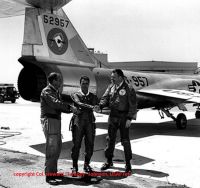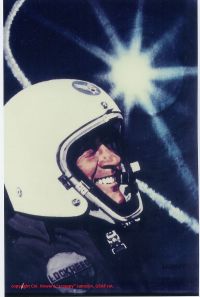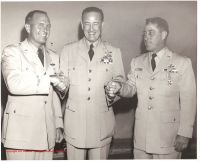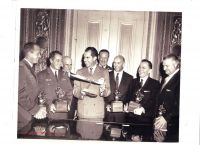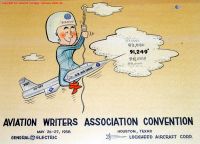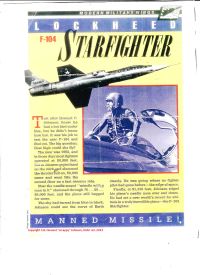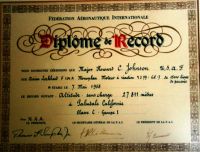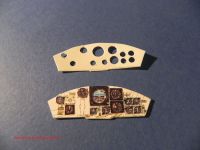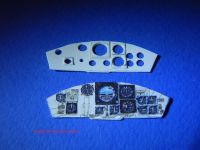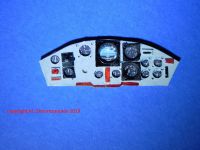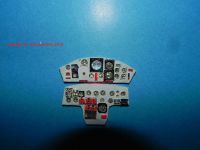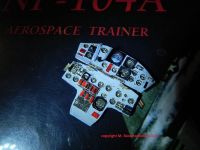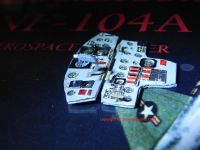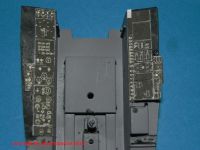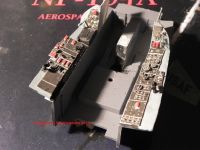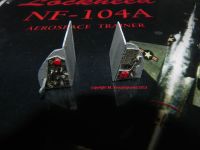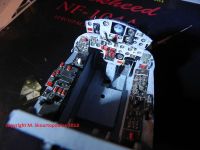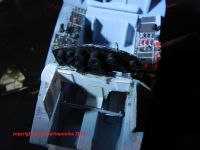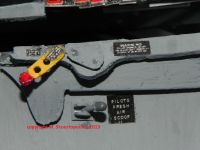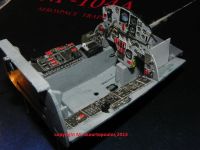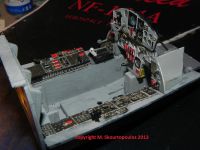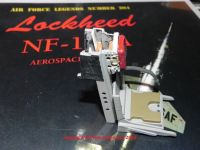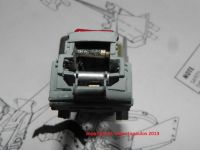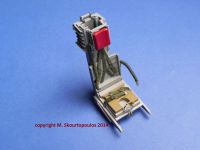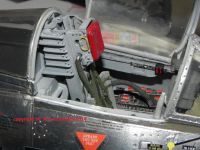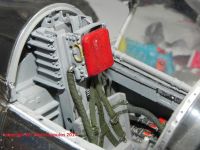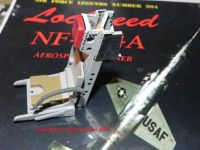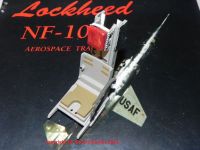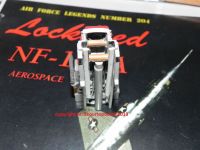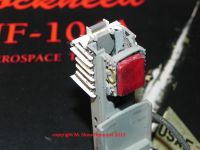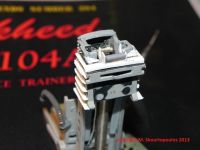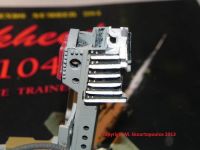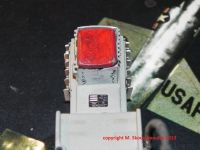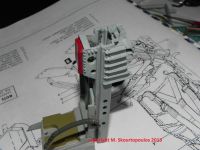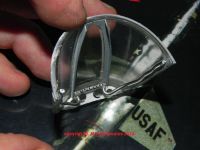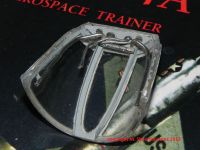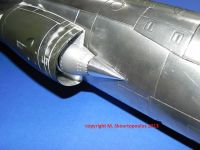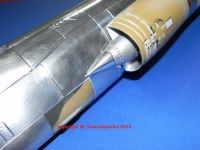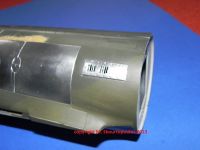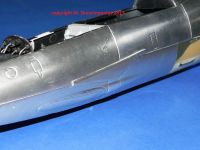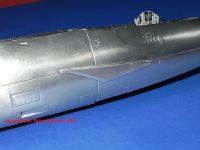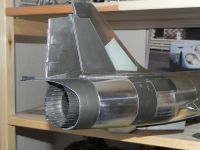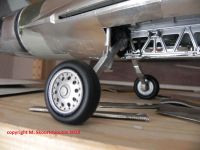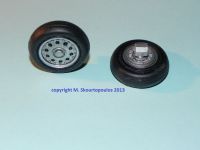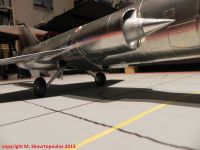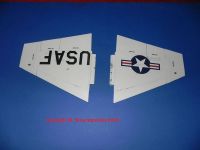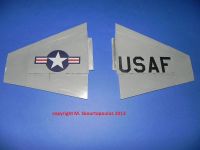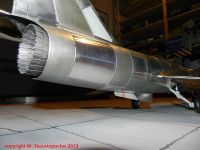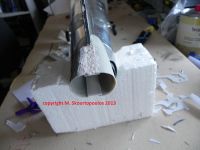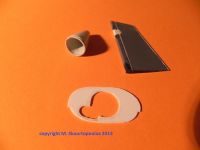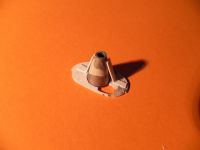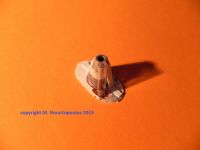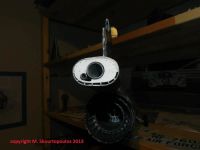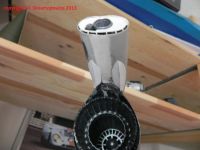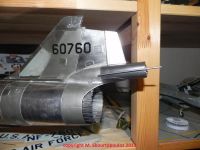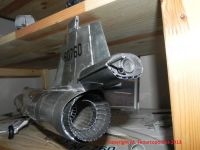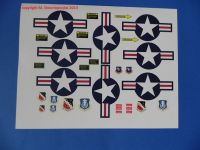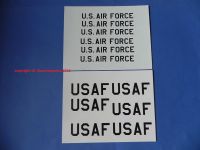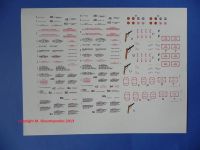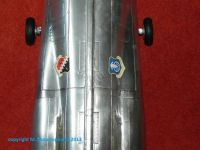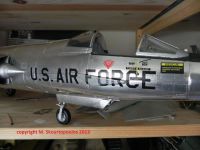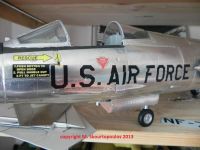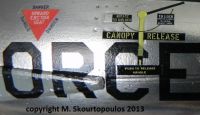Zoom to the Edge of Space: Building the NF-104A Aerospace Trainer in 1/18 Scale
By Dr Menelaos Skourtopoulos
Zoom to the edge of space
Building the NF-104A Aerospace Trainer in 1:18 scale
by Menelaos Skourtopoulos & Col. Howard "scrappy" Johnson (USAF ret.)
Part I
Introduction
The Lockheed F-104 Starfighter needs actually no comments. It was the manned missile for the pilots that flew it and the widow maker for the press. The Starfighter is a kind of an enigma in the aviation history and it was massively misunderstood using it as a fighter/bomber, a role that it was never built for. Its role was the pure point high altitude interceptor with its light weight philosophy.
One of the hottest 104s that ever build is the NF-104A. It was a modified F-104A which was flown as a (future) astronaut trainer by the USAF Test Pilot School, and fitted with a 6,000 lb LR-121/AR-2 rocket motor. That means zoom climbs at 120,000 ft literally to the edge of space. Three F-104As (56-756, 56-760 and 56-762) was converted to the NF version.
The difference from the F-104A was the tail mounted rocket engine, the increased chord fin and rudder assembly (as on the F-104B and later G), longer span, revised intake shock cones for higher mach numbers, and small reactive rockets on the nose and on the wings.
Typical flight envelope was starting the rocket at 35,000 ft for two minutes and mach 1.9 and burning out at 100,000ft. The jet engine was shut down at 80,000 feet and restarted on the way down below 60,000 ft. Famous test pilot Chuck Yeager almost killed himself after the 56-762 went into a flat spin (he couldn’t push the nose down to restart the J79) and bailed out at about 6,000 ft. Unfortunately the rocket of the C2 seat hit him on the face and burned him badly, but Yeager survived. Only 56-760 survived and today is still a gate guard outside of the USAF Test Pilot School.
Records
The NF-104A was not the first Starfighter that broke altitude records...long before the NF-104 was born and back in the '50s there were many attempts to fly higher.
First to fly with a regular F-104A over 90,000 ft was Howard Johnson of the 83rd FIS.
Even he never flew the NF-104A he is the first pilot (he also never been a test pilot at all) to break the world altitude record with a regular F-104.
Col. Howard "scrappy" Johnson flew over 7,000 hours in 15 different fighter planes. He was awarded 2 silver stars, 7 distinguished flying crosses and 18 air medals for flying in the Korean and Vietnamese wars, and the Collier Trophy for breaking the world’s altitude record. It was in October 1967 that Col. Johnson completed his 117th mission (101 over North Vietnam and 16 over Laos) in the F-105. He also became the founder and first president of the Red River Valley Fighter Pilots Association that still prospers and has given hundreds of scholarships to sons and daughters of POWs and MIAs. He has also recently been inducted in the Kentucky Aviation Hall of Fame.
Over one year ago I emailed with former and legendary F-105 pilot Col. John Piowaty (USAF ret.) (see my article for the F-105D 1:32) about my intention to build the NF-104A in that big scale. He then helped me to make a contact with the famous Col. Howard "scrappy" Johnson. He immediately agreed to be my co-author and adviser for this article. So, I'm very happy to made contact with him and I'm very proud to have him as a co-author. He's a great man and gave me a lot of advice and information and he's definitely one of those men having the "right stuff".
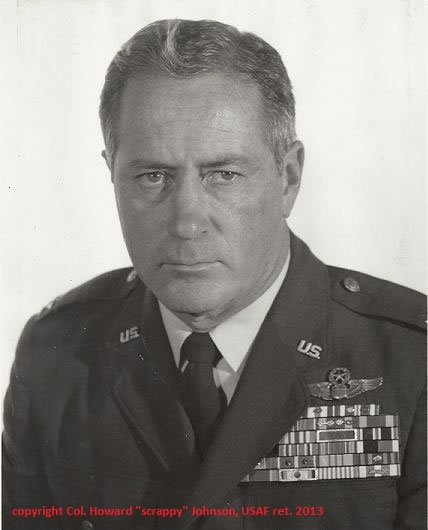
Here are his memories of that mission:
"The day I flew a F-104A (it was May the 7th, 1958 and the aircraft it was the 3rd YF-104A No 55-2957, then on service with the 83 FIS) into the aviation record books, scores of Lockheed executives were on hand, as were a host of other dignitaries. All were visibly apprehensive, some down-right sceptical, because my practice flights had not taken me very high.
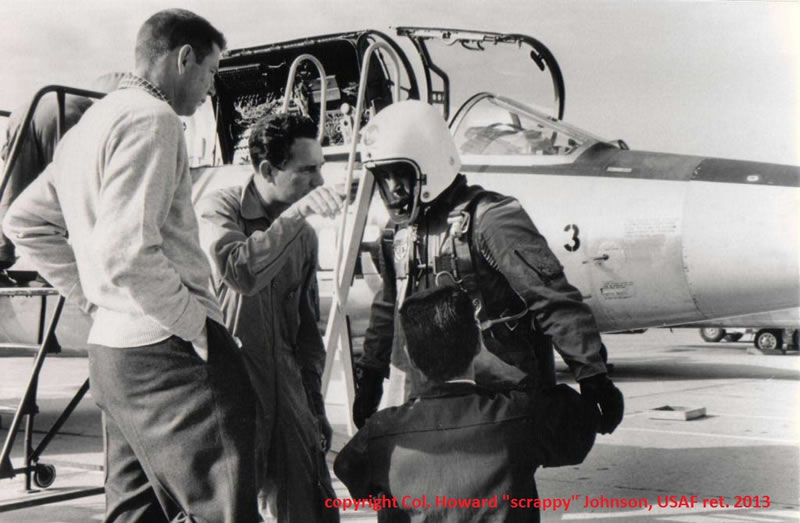
I, too, found myself very anxious that morning as I strapped into the cramped cockpit. Minutes later I taxied out, positioned myself on the centerline at the end of the active runway and waited for the "go" from the tower.
In order for me to have sufficient room for a zoom, my track had been meticulously designed so that the apogee of the climb would take place directly over Edwards AFB. This was were the official radar and cameras had been set up to record my exact altitude as I went over the top.
To ensure my success, several things had to happen in rapid sequence and each at the appropriate moment. First I needed to obtain optimum speed, then burn off just the right amount of fuel so as to be in precisely the right location at the start of my climb. The magic formula was a simple one: The less flue I had onboard, the lighter the plane, and the lighter the plane, the higher I'd go (the 3rd YF-104A had the internal gun removed for that mission). BUT with one very important caveat. I hoped to have enough fuel in my tanks to make it back to the field and land...
I was climbing. The clear cobalt blue skies afforded Palmdale, California, no cover. Landlocked and naked, the city stood at the mercy of the same sky that now gave may F-104A life. I couldn't help but laugh to myself. Here I was, getting paid to do something a Leonardo da Vinci would probably have given his right hand for. Me scrappy Johnson, a Kentucky boy soaring with eagles and not frying chickens. Grandma's "Golden boy" at the controls of the Air Force's newest and best performing fighter plane ever build.
As I headed for the coast, I gently coaxed the little aircraft up to 43,000ft, executed a turn over Santa Barbara and made a beeline for Edwards.
Nailing the course, I moved the throttle lever to full afterburner and the Starfighter leapt forward. The airspeed indicator moved up rapidly until it showed I was ripping through the air at Mach 2.23. The only sound I could hear was my own breathing.
I carefully eased back on the stick and pointed the airplane's nose to the recommended 52-degree angle of attack. The F-104A hammered the air from 70 to 60 thousand feet, then, as predicted, at 63,000ft the afterburner was cut out and at 67,000ft the engine quit. Not enough oxygen. May partial pressure suit automatically inflated. I was now in a glider. The Starfighter, a rocket whose fuel had been spent, continued to climb.
I blasted through the 70 then 80 thousand feet, and still kept ascending. The ailerons, which also act to stabilize the plane, were fast losing their effectiveness: I was now having trouble keeping the wings level. The moment I went over the top I glanced down my airspeed indicator. Thirty knots. I was barely moving.
The sky was a dark purplish-blue and I could readily make out the curvature of the earth. The engineers later said I could have seen as far as Salt Lake City had my eyesight been good enough - and had I taken the time to look. I didn't. I should have experienced the stick kicker, but it had been deliberately disabled before takeoff.
On my way down, the radar operator at Edwards radioed that I had reached 91,249 ft (27,813 m), which meant I had just broken the world's altitude record by over 14,000 ft!
Continuing my gliding descent, I turned toward Palmdale, and at 47,000ft I started the General-Electric J79 engine. My pressure suit deflated and I began my dash forwards the plant where the anxious crowd awaited the results.
I entered the traffic pattern at Palmdale with less, that 400 pounds of fuel, landed without incident and taxi to the ramp. Tony LeVier, Lockheed's famous test pilot, climbed up to the now-opened cockpit, reached in and pumped my hand. I was mentally and physically drained, but managed a huge grin.
Such an opportunity does not come often in life, and had I muffed it, I would have surely regretted it for the rest of mine."
Building the NF-104A in 1:18 Scale
I already made a NF-104A model many decades ago, using the Hasegawa F-104G in 1:32 scale (link). But this time I wanted a much bigger and testier Starfighter to achieve the same thing. The 21st century toys...toy is really a fortune for all those that love building huge models...and of course Starfighter lovers. I have already some experience with that model building it as a Hellenic Air Force F-104G some years ago, and already started a conversion to a TF-104G.
The challenge was now, how to build the NF-104A using that model... First you have to know, what are the changes and additions you have to make.
- longer wing span (2 ft in the real plane)
- longer inlet cones
- all metal Radome with longer and thicker yaps head boom
- RCS on nose ( 4 pairs) and wings (on top and bottom)v
- revised cockpit (no radar, no HUD), different side panels and C2 ejection seat
- longer fin (G style)
- Spin fairing all the way back around the fin bottom
- LR121 AN1 rocket engine
- reinforcement (?) panels on fuselage under the cockpit (both sides - at least by 56-760) painted ADC grey
- UHF antenna blade under the fuselage (only 56-760) in front of the front landing gear
- Scoop and vent on the right side are of the later type found on the C and G models
- A/B type wheels, landing gear legs and doors
- no arrestor hook
- natural metal overall except white wings (top) and ADC grey (bottom)
- badge of the test pilot school and air force systems command on mid fuselage top (later small test pilot school badge on the bottom of the fin)
- black or olive drab anti glare on top of Radom (#760 had it in both, the other two in black)
So, first of all I had to find a C model of the 1:18 Starfighter. There is one but is getting very hard to find it on the market as time passed away...
I got one (in the SEA-camo version) and that is a must because that model has the A/B/C type wheels and I need them. OK, yes I know the tail is the short one, but no problem; I took one from my 4 F-104Gs I bunkered during all those years...!
First of all I had to take the whole thing apart. There are many screws to removed and the are being rubber covers, that after the pulled out they are useless. So you have to close that big holes with putty.
I started again with the cockpit. The cockpit inside that "kit" is almost useless. The only thing I kept was the C-2 seat and the cockpit tub. The front panel was copied up to the 1:18 scale using drawings of the real one. You could find these in the Detail & Scale book of the F-104. I used the sandwich technique for creating a 3D effect of the front panel.
For the side panels I first made copies scaled up to 1:18. Then I started building the 3D details on them by using plastic styrene sprues in various sizes. That gave the whole thing much more 3D realism.
Inside that kit there's a not bad C2 ejection seat that gives you the chance to make something looking good out of it...
I start building the head rest, the oxygen tube, flattened the structure on the side walls (it's really very thick there) and next building the rocket tube behind the seat. I used sheet styrene to rebuild the structure of the head bulk that stabilise the seat during the ejection.
The front canopy was a kind of a challenge. The canopy piece from the kit is a very good basis to start making details. I used plastic styrene sheet and wire to represent the missing details and what actually a 104 pilot sees. The same happened also with the moving part of the canopy. The real F-104 has myriads of details that are missing more or less by the most of the kits in any scale. The 1:18 toy is not much better even worse so there's only one way: do it from scratch...
Fixing the two fuselage halves need much careful and as I wrote above you have to cover the holes for the screws and sand them smooth. The NF-104A used the G-type fin and one of my back up "Gs" saved the day. The NF had longer inlet cones. They made from thicker aluminium foil. Don't forget to build the large plates under each side of the cockpit. some As had them some not. But the 760 had them.
For fixing the main landing gear legs (that are not in a good shape) I had to make some preparations for fixing it first in the right position and second to carry safely the "huge" weight of the finished model. Please take a look at my article building the F-104G for more information, the technique is the same (link).
But I had to make the main gear legs much thinner (the G-Version legs where much stronger than the legs of the US Starfighters).
The A/B/C/D type wheels are very well done. This is a very welcome future of the "kit" that makes things much easier and faster.
The main gear doors are for the G-Type with the a big bulge on each of them. So cut them out, and covered it with sheet styrene -ready.
Next step the long wings. This is THE NF-104A future for sure. The original wings took a 2 ft extension for better handling in the stratosphere and one more special feature: the exhaust of the RCS for maneuvering in the thin air of 120,000 ft and beyond.
I made those extensions using sheet styrene. I scaled up to 1:18 the NF-104A drawing plans from Scott Libis book for the reason. Then it's easy to make them. The top of the wings was painted white and the bottom ADC grey.
Notice that there was a modification on the roll-axis plumbing of the RCS on the wings for the last NF-104A versions. At the edge of each wing there was a ventile tube for releasing fuel in emergency.
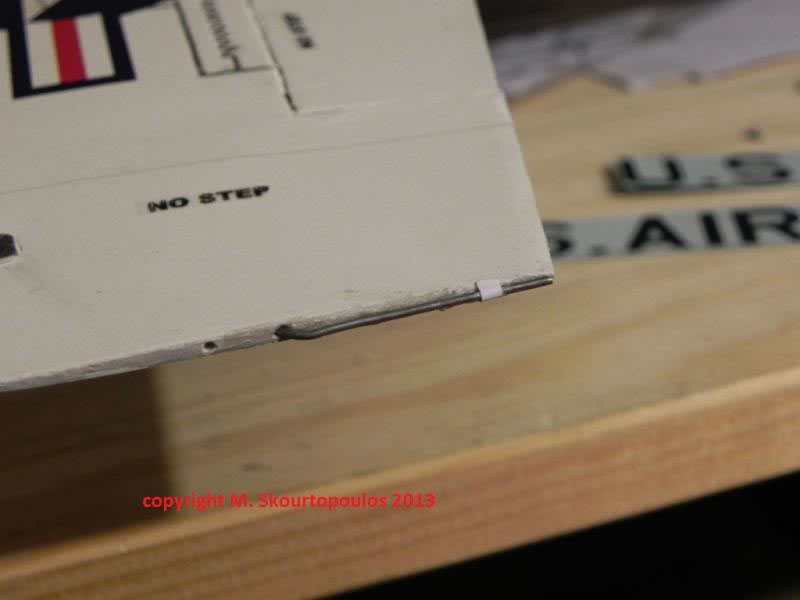
Now back to the fuselage. After covering the screw holes I had to close the opening of the Vulcan canon. The NF-104A (and many other A’s) didn't had it inside for saving weight and carrying the H2O2 and GN2 tanks and electronics. I used first a lot of putty and then started sand it smooth.
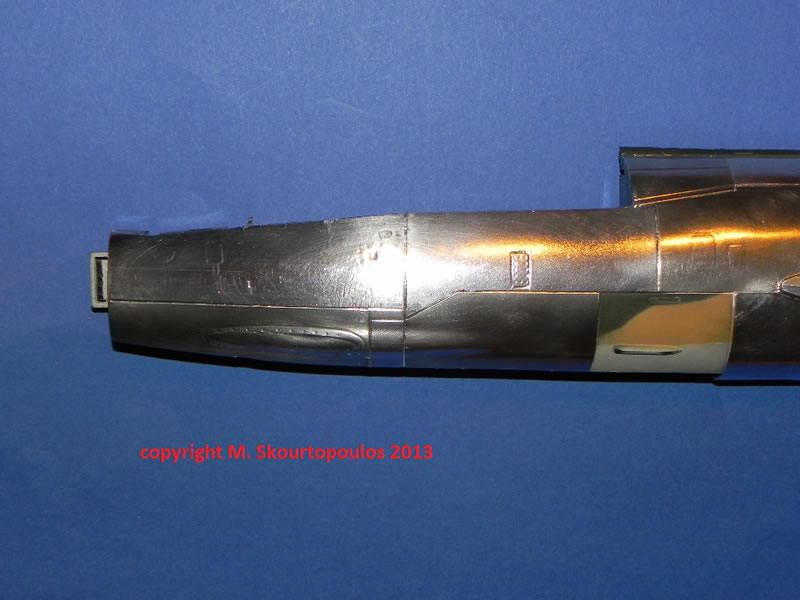
The end of the J79 jet engine is not bad, but it's too narrow and simple at the afterburner region. So I had to make some work here using only the nozzle and a lot of plastic styrene.
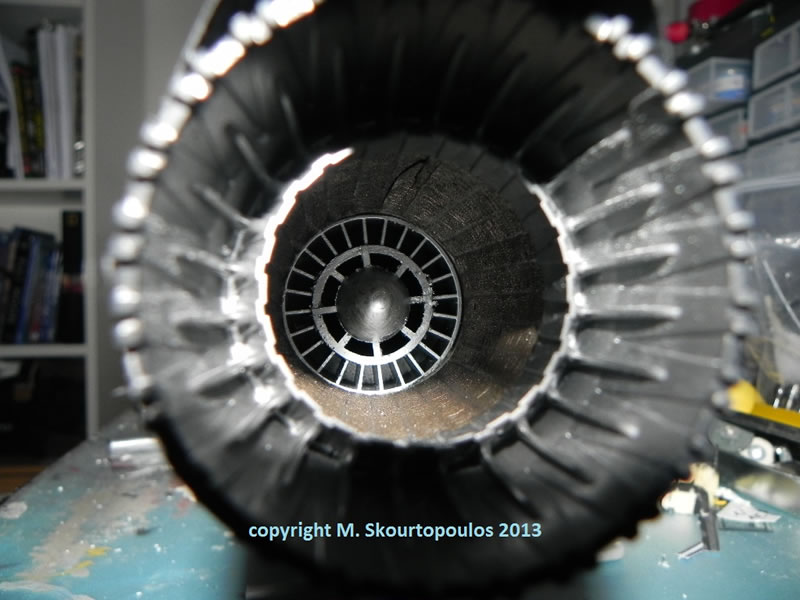
After that, the question came up: which way to represent the natural metal finish? The real thing was in the "good old days" in natural metal finish that means high polished aluminium (it looked almost like a mirror). My original plan was to use Alclad, but I chose the (much healthier) bare metal foil solution. I used many sheets of them using chrome or aluminium. The result is more than a satisfaction!
The next challenge was the next BIG NF-104A future: the LR121 AN1 rocket engine under the "G"-type fin. I used an old centerline tank of the F-4F 1:32 Kit for the major shape. I had to put it into boiling water to give it the right shape. Again plans of the rocket engine in 1:18 scale were used for that. The details at the end of the rocket are made by sheet styrene and wire. I made the rocket engine after I put the bare metal foil on the model. The reason why was that it was much easier to place the engine over the already with foil covered fin, but it's not a must.
Under each cockpit there was a large reinforcement plate, painted ADC grey. I made them from plastic styrene.
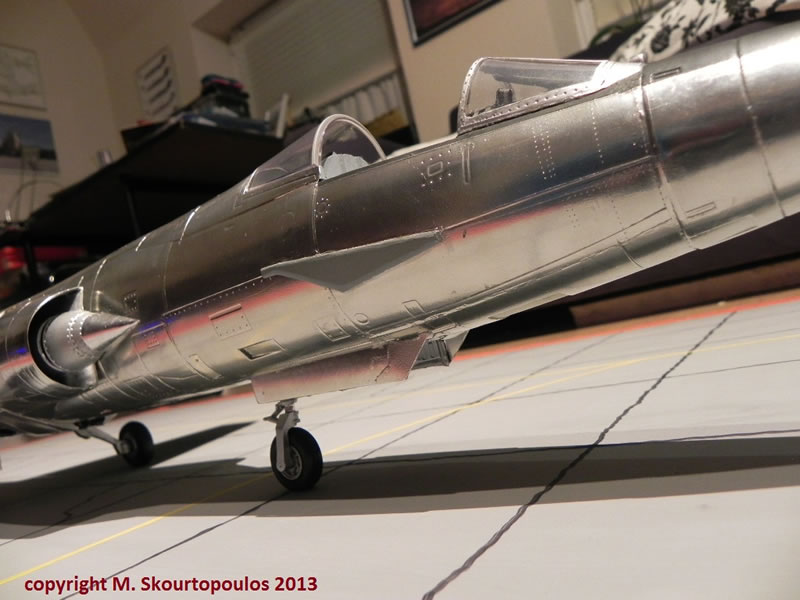
Rivetting the whole aircraft was a kind of a a nightmare, because of the dimensions of the model...but it was worth it.
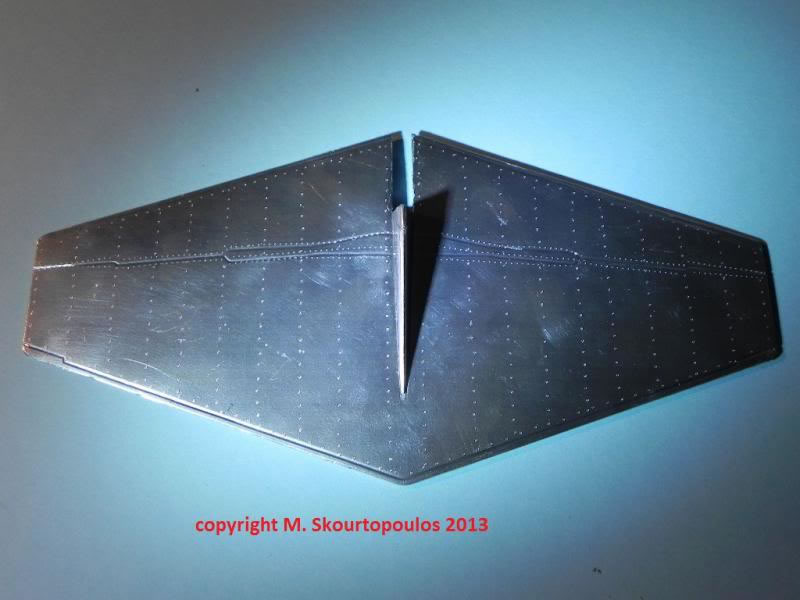
The NF-104A hasn’t the normal pitot tube seen on the other Starfighters but a big long instrumentation boom. I made this using a file and the front part of the kits pitot tube. The small antennas were made from plastic styrene.
OK the bare metal foil in such huge surfaces is not a big deal, but what about the 1:18 stencils? Specially for the NF-104A there's nothing ready to use out there. So again only one way: do it myself.
I used several sources to find the badges of the test pilot school and air force systems command and the big USAF insignia. The rest of the stencils were made on my PC and printed on decal sheets. The REMOVE BEFORE FLIGHT flags are also self-made.
After one-and-a-half years the huge NF-104A model was ready.
This article is dedicated to the men and women that flown and serviced the Starfighter.
I wish to thank Col. Johnson and Col. Piovaty for their help and support. These are truly great men.
Part 2 will be linked here when it is ready...
© M. Skourtopoulos & Col. H. Johnson 2014
This article was published on Thursday, June 19 2014; Last modified on Tuesday, April 26 2016


